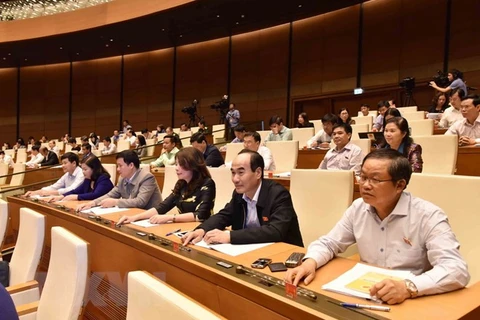Hanoi (VNA) - The Comprehensive and Progressive Agreement for Trans-Pacific Partnership (CPTPP) agreement is expected to aid Vietnam's exports, especially textiles and footwear industries, when it takes effect, according to experts.
One of the key contents of the CPTPP is the removal of 95-98 percent of tariff lines as soon as the agreement enters into force. The remaining tariff lines will be cut over the next seven years, moves predicted to aid the growth and export turnover of the two industries.
Vietnam’s garment and textiles export turnover hit 25.2 billion USD in the first 10 months of 2018, up 17.1 percent year-on-year. Meanwhile, footwear exports were valued at 13 billion USD, 9.7 percent higher than in the same period last year.
The export turnover of garment and textiles recorded growth in key markets such as the US, the EU, the Republic of Korea, China and member nations of the CPTPP.
According to the Vietnam Textile and Apparel Association (VITAS), the CPTPP will help Vietnam accelerate its growth and make the export market more balanced. The zero-percent tariffs will help the country’s textile and garment industries expand market share in countries with high tax rates like Canada, New Zealand and Australia.
Vietnam’s export turnover of the industry is forecast to reach 35 billion USD in 2018. The figure is expected to climb to 50 billion USD in 2025.
Experts, however, also pointed out difficulties facing the sector.
The CPTPP sets strict requirements on product origin, which is a big challenge for Vietnamese enterprises and the textile and garment and footwear sectors in particular, as they are heavily dependent on material sources imported from China, India and other ASEAN countries.
Truong Van Cam, Vice President of VITAS said the current source of materials for Vietnam’s textile and garment industry is limited.
The US, the EU and Japan are now the three largest export markets of Vietnam.
Vietnamese exporters have been advised to continue promoting the support industry, and ensure the origin of raw materials for production.
For the footwear industry, the CPTPP is also an opportunity for exporters to expand their markets to Chile, Australia, New Zealand, Mexico and Canada and Japan.
Experts said Vietnamese exporters of footwear have great opportunities to sell products in Japan, one of the key markets for the sector.
If enterprises know how to make full use of terms from the CPTPP, growth in this market is likely to increase, they stressed.
Vietnamese businesses will also have more opportunities in Canada, which will impose a zero import tariff on both leather shoes and handbags immediately.
However, to benefit from this agreement, footwear enterprises will have to overcome considerable challenges.
According to Nguyen Duc Thuan, Chairman of the Vietnam Leather and Footwear Association (Lefaso), businesses should explore regulations related to customs procedures and logistics of member countries of the CPTPP, while improving the quality of their products.
The government should support enterprises by creating a fair playground and minimising administrative procedures to protect Vietnamese firms in the domestic market, Thuan said.
Phi Ngoc Trinh, General Director of the Ho Guom Garment Group, said his company has invested in equipment and built more factories and production lines to meet quality standards of fastidious markets.
Meanwhile, Vu Duc Giang, Chairman of the Board of Directors of Bao Minh Textile JSC, said all production lines of the firm use the most advanced equipments from famous global brands.
Each year, Bao Minh provides more than 35 million metres of high quality fabric for the fashion brands.
The firm has contributed to increasing the supply of raw materials in the country, helping businesses reduce imports of raw materials. -VNA
VNA

























